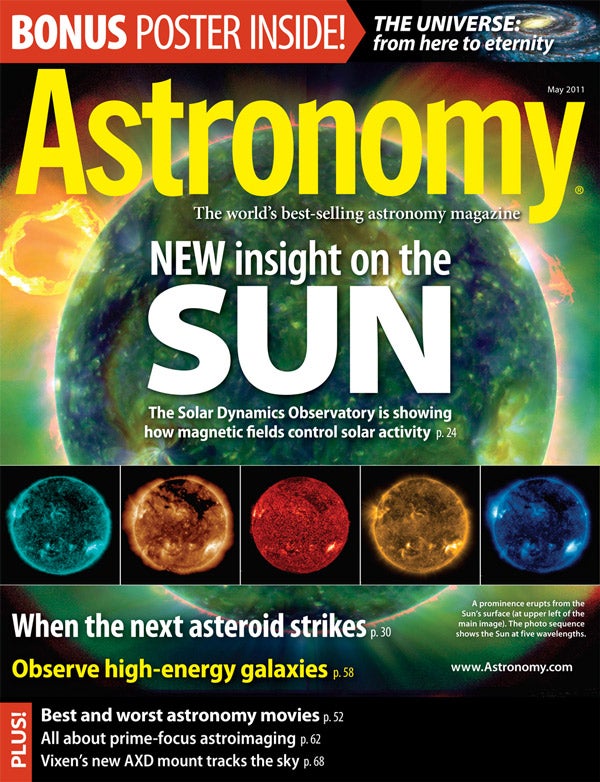
Waukesha, Wis. — In February 2010, NASA launched the Solar Dynamics Observatory (SDO) to begin a 5-year study of our Sun. This satellite is just 1 year into its mission and has already helped scientists increase their understanding of our star. Project Scientist W. Dean Pesnell explains what SDO has accomplished and what else scientists hope to learn from the satellite in “Opening a new window on the Sun.”SDO uses three instruments to measure both the motions of the Sun’s surface and the magnetic fields there. Solar flares, coronal mass ejections, and sunspots are all phenomena associated with magnetic fields. Scientists hope SDO observations will help them learn more about the cause and effect of these events. And with the Sun’s 11-year magnetic cycle just ramping up, they should gather a lot of data. For more information about SDO and what it has taught scientists about our nearest star, pick up the May issue of Astronomy, on newsstands April 5.
“The universe — from here to eternity”
Senior Editor Richard Talcott and Illustrator Roen Kelly have created a never seen before graphic tour of the cosmos, from the inner solar system out to our Local Supercluster — a huge gravitational grouping of galaxies. Use this eight-page poster jam-packed with information to understand how our planet fits in with the scale of the universe, and learn about our cosmic neighborhood in the process.
“What will happen when the next asteroid strikes?”
Planetary scientist Clark R. Chapman describes recent asteroid impacts on Earth and the chances of a large collision happening anytime soon. Are we prepared to deal with the consequences of such an event? Chapman also explains the hazards of near-Earth objects colliding with our planet, and possible ways to deflect the object or lessen the devastation.
May night-sky events visible without optical aid
- Venus and Jupiter, the two brightest planets, lie close to each other in the east most mornings this month.
- May 6 — The Eta Aquarid meteor shower peaks just before dawn. The crescent Moon will set hours before, so under a dark and clear sky, you can expect to see about 70 meteors per hour at the peak.
Also in the May issue
- “Hollywood astronomy” — Astronomy and space have influenced movies for more than a century. What is it that keeps audiences coming back for more?
- “How to observe high-energy galaxies” — Seyfert galaxies emit strange light that comes from supermassive black holes. Even better — many make great telescopic targets.
- “All about prime-focus imaging” — Capture star clusters, nebulae, and galaxies using a telescope as your camera’s lens.
- “Track the sky with Vixen’s AXD Mount” — Spot-on accuracy and an ultra-cool controller place this mount at the top of the heap.
- “The Sky this Month” — Exclusive pullout star charts will guide you through the night sky.
- The May issue of Astronomy also includes Astro News, Bob Berman’s Strange Universe, Glenn Chaple’s Observing Basics, David H. Levy’s Evening Stars, Stephen James O’Meara’s Secret Sky, Tony Hallas’ Imaging the Cosmos, Ask Astro, Reader Gallery, Deep-sky Showcase, The Cosmic Grid, New Products, and Letters.









